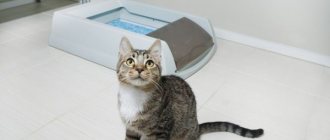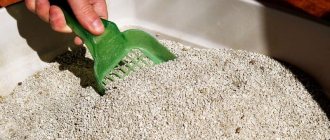The appearance of blood in a cat's stool causes fear in the pet owner. The causes of bloody feces in a pet are varied - from damage to the sensitive mucous membrane of the anus due to constipation, to serious pathological processes developing in the internal organs. The vast majority of them are associated with diseases of the digestive system.
The color of heme fractions secreted with feces deserves special attention. Thus, the appearance of scarlet blood, without signs of coagulation, signals disorders in the rectum or parts of the large intestine. Dark-colored blood may indicate a malfunction in the upper parts of the digestive system.
The appearance of blood fractions in a cat’s feces is a serious symptom indicating disorders in the body. It is recommended to consult a veterinarian for diagnostic measures and the appointment of an adequate treatment regimen.
Symptoms indicating blood in your cat's stool
A few drops of blood present in the animal's stool may indicate minor damage to the rectum as a result of the natural passage of undigested pieces of food or small foreign bodies. The owner does not need to worry about the fact that his cat pooped blood if the pet remains in good health and has an appetite.
If your cat poops blood, she may have serious problems with her body.
A single injury to the rectum does not cause much inconvenience to the pet. The person cleaning the tray needs to be wary if:
- the cat goes to the toilet with blood more than once;
- became lethargic;
- his appetite has decreased;
- he avoids physical contact.
A change in the animal’s body temperature also indicates serious disturbances in the cat’s body. If such concomitant symptoms are present, it is recommended that your pet make an appointment with a veterinarian. Immediate consultation with a doctor is necessary if heavy bleeding is detected that continues even after completion of the bowel movement. Urgent veterinary attention is required if the cat poops with blood, vomits, or makes plaintive sounds indicating pain during bowel movements.
The process of defecation is accompanied by complaints due to painful sensations
Attention! If such symptoms appear in a kitten, delay in contacting a veterinarian can cost the furry patient his life.
Symptoms that require you to visit a veterinarian
If an adult cat or kitten poops with blood at least once, the owner should be wary and monitor the general condition of the pet. It is dangerous to postpone a visit to the doctor if, in addition to blood inclusions in the feces, you are concerned about the following pathological symptoms:
- profuse vomiting;
- breathing problems;
- black feces or feces streaked with bloody mucous;
- frequent urination;
- increased thirst;
- increased body temperature;
- lethargy, drowsiness, loss of consciousness, coma.
Reasons for negative manifestations
The dog doesn’t poop: what to do if it hasn’t gone to the toilet for a day
Droplets or streaks of blood in the stool may appear as a result of cancer, poor nutrition, the development of an infectious pathology, or infection with parasites. In order to make a preliminary diagnosis, the veterinarian needs to know about the accompanying symptoms, including the frequency of the animal’s visits to the tray, the volume and consistency of the masses after defecation.
Helminthiasis is the cause of blood
Parasites that attach to the walls of the rectum or intestines damage the mucous membrane and contribute to the destruction of capillaries. As the feces move, they provoke the appearance of small wounds, and small bloody streaks appear in the stool. The long course of the pathology is accompanied by increased fatigue and loss of appetite.
The long course of the pathology is accompanied by increased fatigue and loss of appetite
Chronic colitis
Regular digestive problems cause a pronounced deterioration in the animal’s condition, a decrease in its appetite and the frequent appearance of bloody discharge in the feces. Colitis is provoked by an inflammatory process and is accompanied by a moderate pain syndrome, so a concomitant symptom is the animal’s refusal to caress the owner and a negative reaction to attempts to palpate the tummy.
Chronic constipation
Poor nutrition, mainly cereals or baked goods, as well as a lack of water with regular consumption of dry food, can provoke the development of constipation.
Stagnation causes the onset of the inflammatory process. Then, if the cat wants to poop, he has to push hard, creating additional stress on the vascular system, which provokes bleeding. It can worsen when dry feces containing pieces of tubular bones move through the intestines, which can damage not only the mucous membrane, but also the tissue underneath it.
If the menu is incorrect and there is a lack of drinking water, the cat may develop constipation.
First aid
If blood is detected in the feces, it is recommended to carry out deworming and observe the animal for several days.
If the owner notices blood inclusions in the pet’s stool, but the general condition of the animal is not affected, he should be monitored. In addition, it is indicated to carry out deworming and cleansing of the intestines from pilobezoars. If your cat eats dry food, it is important to provide him with free access to clean and fresh drinking water. You can switch to a natural diet, diversifying it with fermented milk products, vegetables, and cereals. But in this case, you need to first consult a doctor so as not to harm your four-legged friend. If after such measures the cat’s condition does not improve and blood is still present in the stool, it is necessary to undergo tests to find out the cause of this condition.
Dependence of stool color on the level of problems in the gastrointestinal tract
The cat shits: what to do if the cat goes to the toilet anywhere
Small streaks or blood clots in the stool indicate the need to contact a veterinarian to have your pet examined, provided that the stool is of normal consistency.
Important! Scarlet color of stool indicates the presence of bleeding, which can threaten the patient’s life, so you should contact a specialist immediately.
The black color of the stool allows you to understand that cats shit with blood. This color indicates the presence of internal bleeding. Loose stools or a greenish tint to the stool, the presence of mucus in it, may signal the development of an infectious disease.
Diagnosis of the causes of bleeding in cats
The cat often goes to the toilet a little at a time
Helping a cat not go to the toilet with blood can only be done by eliminating the cause that caused the damage and treatment aimed at tissue regeneration. Only a veterinarian can select the appropriate therapy after conducting a comprehensive examination of the patient.
The doctor begins the appointment with an analysis of the person’s complaints that the kitten is pooping with blood, then he needs to obtain the most complete information about the living and nutritional conditions of his patient:
- Diet. The veterinarian needs to know whether dry or natural food predominates in the animal’s diet. How often and in what form does it receive vitamins? Additionally, the possibility of your pet eating bones is clarified. It is determined that there is free access to clean water.
- Infestation with parasites. Disturbances in the functioning of the digestive system often occur with helminthiasis, so the doctor needs to know the date of the last treatment. When planning an appointment with a veterinarian, it is recommended to clarify the name of the drug that was given to the cat to remove parasites.
- External condition. When cleaning the skin, long-haired animals can swallow lumps of hair, which sometimes injure the mucous membrane when passing through the intestines. High temperature, mucous discharge from the nose or eyes, lethargy may indicate the development of an infectious pathology. Bleeding that does not stop at rest, or an animal’s acute reaction to touch can become a signal of serious damage to the intestines, including as a result of cancer.
- Access to dangerous objects. The animal's tendency to check the trash can, play with unfamiliar things, climb into the most unpredictable places, and gnaw on plants is clarified.
- Going outside. Walking in the fresh air without control from the owner allows the animal to hunt, try different foods, even drink from puddles. All this leads to infection of the body.
- Associated symptoms. Temperature, appetite, and general condition can tell the veterinarian what caused the pathology.
The general condition of the cat can tell the veterinarian what was causing the concern.
A personal examination of the animal and a veterinarian interview with its owner is not enough to make a diagnosis. To find out the reason why kittens poop with blood, additional blood tests are prescribed, biochemistry, and laboratory testing of feces and urine are performed. Instrumental diagnostic methods are also used, including x-rays, ultrasound and colonoscopy.
If chronic inflammation in the intestinal tissues or tumor formation is suspected, the veterinarian resorts to a biopsy method. Taking a small piece of tissue for research is a painful procedure, so access to it is recorded quite rarely.
Diagnostic methods
To determine why a cat has bloody stool, a coprogram and a bacterial test of the sample are performed. The procedures help to identify possible abnormalities in the gastrointestinal tract, the presence of worm larvae and the presence of protozoa or bacteria. Additionally, it is necessary to donate urine and blood. The results can indirectly confirm the presence of inflammation. Based on the data obtained, it is sometimes possible to draw conclusions about the location of the disease.
If during the initial examination it was not possible to identify abnormalities, additional procedures are performed: ultrasound and x-rays. Sometimes a rectal examination is required.
The data obtained from collecting anamnesis is of key importance. The following information should be provided to your veterinarian:
- cat's diet and diet;
- presence of chronic diseases;
- time of onset of symptoms;
- frequency of deworming;
- date of last vaccination.
It is necessary to analyze whether the cat may have accidentally eaten spoiled food or swallowed potentially dangerous objects, such as Christmas decorations, needles or bones. If you have other atypical symptoms (diarrhea, increased attention to the anus, the habit of rubbing against carpets), you should warn a specialist.
https://www.instagram.com/p/BueGk3JAOxP/
Treatment of a cat if blood is detected in the stool
The therapeutic plan is drawn up taking into account the cause of the disease. Treatment in a veterinary clinic is required only for animals in serious condition. In most cases, a cat needs to be treated with medications, and the owner needs to ensure that the pet not only takes medications in a timely manner, but also has high-quality nutrition during this period.
Attention! If malfunctions of the pancreas or liver are detected, the cat is recommended to follow a diet and take medications with enzymes, for example, Pancreatin.
Probiotics and antihistamines are added to proper nutrition to treat dysbiosis, allergic manifestations, and colitis. Switching your pet to medicated food low in allergens and preservatives reduces the risk that the kitten will poop blood again. Additionally, vitamin complexes may be prescribed.
Infectious diseases require taking antibacterial or antiviral drugs and vitamin complexes. If the animal begins to defecate with the appearance of blood in the feces due to helminthic infestation, the veterinarian prescribes appropriate antihelminths (Alben, Mibelmax, Drontal). Additionally, the animal may require a course of immunomodulators and probiotics.
In case of heavy bleeding caused by intestinal injury, the patient is recommended hemostatic drugs in the form of injections. After stabilizing the patient’s condition, symptomatic therapy is selected taking into account the severity of the existing injuries.
Important! The indication for surgical intervention is the presence of a foreign body in the cat’s digestive system or the detection of a neoplasm in it.
After surgery, the animal requires competent care for rehabilitation, including a strict diet. At the first stage, the cat is fed only natural food, then it is allowed to switch to super-premium dry food, for example, Recovery.
Natural nutrition includes the inclusion of lean meats, sea fish, and fermented milk products in the menu. Whole milk, fatty or fried foods, and smoked foods are prohibited. Porridges are given only with the permission of a doctor and in accordance with the recommended dosages. Vegetables become the basis of nutrition. The entire daily food intake is divided into 5-6 small portions to prevent overeating. Give boiled water at room temperature.
The diet prescribed to the animal is designed in such a way as to minimize the load on the intestines, so there should be a minimum amount of raw foods in the diet. The daily diet is selected to satisfy the patient’s body’s needs for all essential microelements, while taking into account the inability of a weakened digestive system to process certain types of foods.
This problem can be solved by eliminating potentially harmful foods from the diet and adding enzymes at the initial stage of therapy. It is recommended to entrust the choice of the drug and determine the required dosage to a veterinarian so as not to aggravate the cat’s condition.
Additional Information! When diarrhea occurs, the animal’s body quickly begins to suffer from dehydration, so in addition to means to combat bleeding, the furry patient is prescribed medications to restore the water-salt balance.
What treatment is prescribed?
If polyps or neoplasms are found in the animal’s intestines, the doctor will recommend surgery to remove the growth. Surgical treatment cannot be avoided even if there is a foreign object in the rectum that is not excreted from the body naturally. For infectious diseases, a specific and symptomatic treatment regimen is prescribed. Diseases of the digestive system are treated comprehensively, under the supervision of a veterinarian. In case of poisoning, a drip with an antidote must be placed, the stomach is washed, and then restorative therapy is prescribed. For helminthiasis, anthelmintic drugs are prescribed, and to maintain immunity, vitamin complexes and a special diet are additionally prescribed.
Preventive actions
Annual preventative examinations with a veterinarian allow you to timely identify existing diseases and select appropriate treatment to prevent the development of complications that result in blood appearing in the feces.
Regular consultation with a doctor also allows you not to miss the time of vaccination, and to consult on the most effective and safe drug to combat parasites.
Kittens damage their intestines with poorly chewed food.
When creating a menu for your pet, you must adhere to a few simple rules:
- Constant access to drinking water. The animal needs filtered or boiled water; it must be changed 2-3 times a day. If dust, foreign objects, or liquids get into the bowl, you must immediately replace the water. Before filling the bowl, wash it thoroughly without using household chemicals.
- Do not mix dry food with natural food. Specialized feed contains the required amount of vitamins and microelements, so replacing some of it with natural products can cause a deficiency of nutrients in the body, causing diarrhea and constipation. Kittens who do not chew dry food well have a hard time taking a shit without damaging their intestines. It is enough to switch such an animal to natural food to solve the problem.
- Don't spoil your pet. Some owners use sweet, salty and smoked foods to reward their pet, but even one piece of such harmful foods can be enough to cause problems with the digestive system.
If you suspect the presence of a disease, do not delay a visit to the veterinarian.
Important! Cats are quite curious, so it is necessary to exclude their contact with household chemicals, spoiled foods, and poisonous plants.
Having noticed that the cat has problems with stool, the responsible owner should immediately take measures to improve the animal’s condition. Timely assistance can prevent the development of severe disorders and chronic inflammatory processes. To suspect that a pet cannot go to the toilet due to constipation is the absence of feces in the tray for 2-3 days, as well as its loud, plaintive cries.
Blood in the feces of cats may appear one time due to poor nutrition, but its repeated detection in feces requires contacting a veterinarian. A symptom may indicate a banal helminth infection or the formation of a malignant tumor; only a specialist can make an accurate diagnosis and prescribe appropriate treatment.
How to avoid problems: prevention
If the owner takes a responsible approach to caring for the cat, then problems and malfunctions in the pet’s body rarely arise. So, just a few simple rules will allow a person to protect their pet from health problems.
Firstly, you need to remember that the cat should receive only fresh and high-quality products purchased from a trusted place. If the animal’s diet is based on dry food, then it should be food from a well-known brand, part of the “holistic” or “super-premium” class. You cannot mix natural feeding and drying.
A cat that eats right will live a long and healthy life.
You also need to regularly treat your pet against parasites, both external (fleas, ticks) and internal protozoa (helminths). Treatment is carried out once every four months, regardless of whether the pet goes outside. In addition, the cat must be protected from dangers that could harm the health or even the life of the pet: remove household and other chemicals, do not have poisonous plants, make sure that the pet does not go outside unattended.
A cat, even a completely healthy one, should visit a veterinarian at least once a year. This must be done in order to get annual vaccinations, as well as undergo an examination.
Vaccination minimizes the risk of developing many diseases











